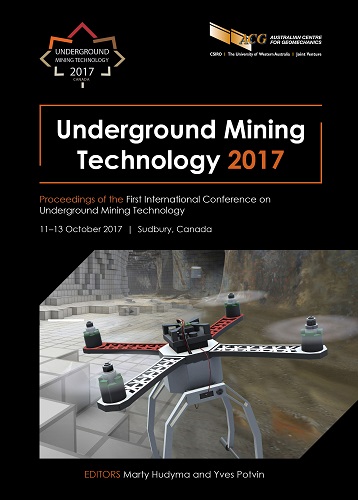Environmental discharge criteria and dispersion estimation for mine ventilation exhaust stacks

|
Authors: Harris, W; Kadiayi, AK; Macdonald, K; Witow, D |
DOI https://doi.org/10.36487/ACG_rep/1710_08_Witow
Cite As:
Harris, W, Kadiayi, AK, Macdonald, K & Witow, D 2017, 'Environmental discharge criteria and dispersion estimation for mine ventilation exhaust stacks', in M Hudyma & Y Potvin (eds), UMT 2017: Proceedings of the First International Conference on Underground Mining Technology, Australian Centre for Geomechanics, Perth, pp. 103-113, https://doi.org/10.36487/ACG_rep/1710_08_Witow
Abstract:
Water droplets emitted from mine ventilation discharge points can have a detrimental impact on the environment, and are being recognised as an important source of emission at mine sites. Furthermore, this can lead to poor fan performance, fan wear and reduced fan efficiency, which in turn translates into an increase in overall operating cost. Droplets are the result of groundwater seepage and/or condensation entrained in the gas stream. Harmful dusts may be incorporated in these droplets. The larger droplets then associated with these dust particles increase their settling velocity and thus dispersion can be substantially reduced. This paper addresses the issues associated with the characterisation of particle size distribution and illustrates energy losses due to droplets in vertical shafts using pneumatic conveyor calculations. Measuring techniques and abatement technologies are also highlighted.
Keywords: mining, ventilation, dispersion, droplet, entrainment
References:
American Society of Heating, Refrigerating and Air Conditioning Engineering (ASHRAE) 2015, ‘Building intake and exhaust design’, ASHRAE Handbook: HVAC Applications, ASHRAE, Atlanta.
Boyko, K & Smith, T 2010, ‘Innovative use of a mist eliminator in mine ventilation’, Proceedings of the 3rd International Conference on Uranium.
Derrington, AS 2002, ‘Control of water discharge from mine ventilation shafts’, Proceedings of the Underground Operators Conference, The Australasian Institute of Mining and Metallurgy, Melbourne, pp. 317–326.
Klinzing, GE, Rizk, F, Marcus, R & Leung, LS 2011, Pneumatic Conveying of Solids: A Theoretical and Practical Approach, Springer Science & Business Media.
Martikainen, AL & Marks, J 2007, ‘Fogging in mines: the role of visibility, unfamiliar fog removal methods, and future research ideas’, Journal of the Mine Ventilation Society of South Africa, Q2.
McPherson, MJ 2012, Subsurface Ventilation and Environmental Engineering, Springer Science & Business Media.
Ontario Ministry of the Environment and Climate Change (MOE) 2005, R.R.O. 1990 Regulation 346: General – Air, Ontario Ministry of the Environment and Climate Change, Ontario.
Ontario Ministry of the Environment and Climate Change (MOE) 2016, Ontario Regulation 419/05: Air Pollution – Local Air Quality, Ontario Ministry of the Environment and Climate Change, Ontario.
Ontario Ministry of the Environment and Climate Change (MOE) 2017, Air Dispersion Modelling Guideline for Ontario (Guideline A11), version 3.0, Ontario Ministry of the Environment and Climate Change, Ontario.
Perry, RH & Green, DW 2008, Perry's Chemical Engineers' Handbook, 8th edn, McGraw-Hill, New York.
Rhodes, MJ 2008, Introduction to Particle Technology, John Wiley & Sons Ltd, Chichester.
Witow, DR & McCall, J 2010, ‘Engineering innovation at Xstrata's Nickel Rim South surface exhaust fans’, in S Hardcastle & DL McKinnon (eds), Proceedings of the 13th United States/North American Mine Ventilation Symposium, MIRARCO Mining Innovation, Sudbury, pp. 545–552.
© Copyright 2025, Australian Centre for Geomechanics (ACG), The University of Western Australia. All rights reserved.
View copyright/legal information
Please direct any queries or error reports to repository-acg@uwa.edu.au
View copyright/legal information
Please direct any queries or error reports to repository-acg@uwa.edu.au